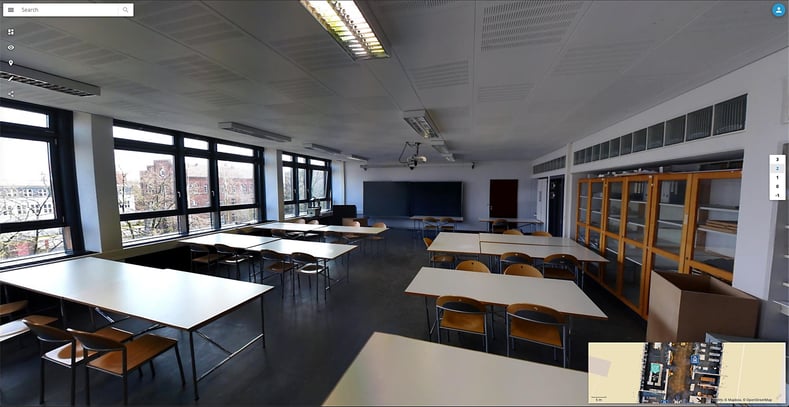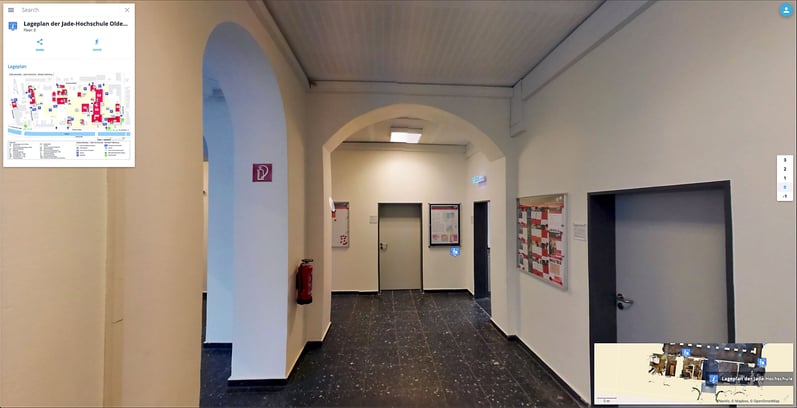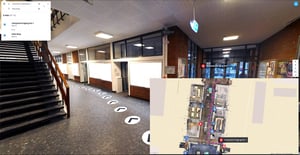A practical use for digital buildings at the Jade University of Applied Sciences in Oldenburg demonstrates their power and their potential for safety planning and security management.
The coronavirus pandemic has had a significant impact on practically all areas of our lives. For the use of public buildings, for example, recommended guidelines for social distancing and public safety have to be put in place at very short notice to maintain access.
For the Jade University of Applied Sciences in Oldenburg, Germany, a pre-existing virtual model of their campus proved invaluable as a crisis-proof communication tool. With staff interacting with digitized assets through NavVis IndoorViewer, a browser-based application, all the critical information was already in place and available for annotation, collaboration, and daily use.
Using their digitized building, Jade University was able to rapidly implement the physical distancing measures required to prevent the spread of COVID-19, and thereby ensure the health and safety of all students, staff, and guests.
The challenges of a classical approach for building operations
The task of examining the specifications for the safety measures and then implementing them fell to the Occupational Safety and Building Management department at Jade University.
The list of requirements was extensive and complex – and they weren’t limited to a single site. The same safety measures had to be applied to three separate study locations at Oldenburg, Elsfleth, and Wilhelmshaven.
This unprecedented situation posed a unique set of challenges for all those involved, not least because the work had to be carried out during ongoing operations and limited time – with staff themselves at risk of exposure to the coronavirus.
The classical approach to this task would be to study the available documentation and look at the possibilities for implementing that safety measures, taking into account requirements like routing, room usage, and placement for disinfectant dispensers.
But if the documentation is not fully aligned with the current “as-is” condition of the building, then additional inspections will need to be conducted, with physical measurements taken on-site, so that personnel have all the necessary information to make valid statements and decisions.
A selection of tasks the occupational safety team had to fulfil:
- The positions of existing fire extinguishers and disinfectant dispensers had to be compared.
- The measurements for the location and acquisition of “spit guards” had to be taken.
- The physical distance requirements in the classrooms had to be implemented while taking individual equipment into account.
- The pathways for one-way mobility in the entrance and recreation areas had to be clearly demarcated.
In addition to all the above, the measures taken had to be properly documented.
Reflecting on the scale of the task that lay ahead of them, the team at Jade University recalled that they had a digital model of the campus already at their disposal. Could that make implementing the safety measures more efficient? It turned out that it could.

Multiple uses for a single digital building model
During the preparation for a basement renovation at the university in 2018, a digital building model was created of the main location at Oldenburg. The complete site was captured by DiConnex, an experienced laser scanning specialist and NavVis Mapping Partner, using the NavVis M6 Indoor Mobile Mapping System (IMMS).
After scanning 12,000 sqm in a single day, DiConnex generated a model that combined high-quality point clouds and panoramic photos. Thereafter, the completed model is available for viewing, exploring, collaborating and sharing from within NavVis IndoorViewer.
The benefit of the model is that exact measurements can be taken at any location, while the panoramic photos comprehensively document the actual condition of the site. In addition, any object of importance – fire extinguishers, for example – can be marked up as a "point of interest" containing additional information.
Using this digital building model, the management team found that information could be searched and filtered very efficiently. All stakeholders can be assigned individual user rights and privileges, and, because NavVis IndoorViewer is accessible from any standard web-browser, it’s available online in the office as a planning tool and on site on a tablet as a database.
When it came to the implementation of the COVID-19 countermeasures, the digital building model proved incredibly versatile. The property could be walked through virtually with all the employees and companies involved, for example, to determine and document requirements. Implemented measures were able to be assigned to the model as a "point of interest" with text and a photo for further details. And the collective decision-making was considerably simplified when many questions were able to be answered when demonstrating the model via video conference.
Most crucially, the need for on-site meetings was avoided in many cases, reducing the risk exposure of the planning team.
Wrapping up
Jade University is now exploring further uses for their digital building model. It has proven its worth in the field of occupational safety and building management; the operations team is convinced that more applications will be found independently of the coronavirus pandemic.



